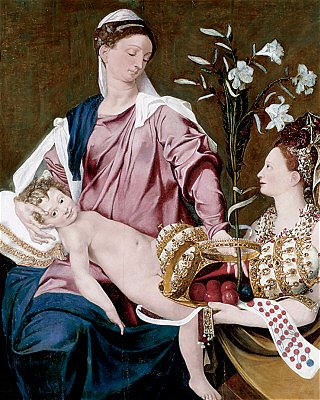In his declining years he painted at the court of the Gonzaga in Mantua where he passed away in 1578 at the age of seventy-four. Subject: Benedetto has created an atypical votive image in which the City of Florence in the guise of the Roman goddess Flora, offers thanks to the Virgin for the glories she has bestowed upon the Medici and especially on Duke Cosimo I. The Virgin Mary was one of the primary saintly protectors of Florence. The symbols offered to the Virgin are: the six balls (coat-of-arms of the Medici); a genealogical tree and two Papal tiaras (the Medici Popes Leo X (1513-21) and Clement (1523-34); a crown (the Duchy of Tuscany); the diadem of pearls encircling a sheaf of Valois lilies (Catherine de'Medici and Henri d'Orleans married in 1533). The Virgin is shown as an aristocratic figure - a symbol of the Medici family power and wealth. The City of Florence is depicted as Flora, Roman goddess of spring flowers, to suggest the state of peace and prosperity under Medici rule. Painting: This is a large painting of the Madonna and Child, who lies passively in her lap, and a fantastically adorned female figure who is holding a plate filled to overflowing with the emblems whose meaning can easily be explained (balls, tiaras, lilies etc.). The painting was purchased by John Ringling in 1927 at Christies in London. Historical Context: It was not surprising that Cosimo d'Medici was pleased to receive a painting which extolled the achievements of the Medici and their "special" relationship to the Virgin, the saintly protector of Florence. There were many in Florence who made anti-Medicean prophecies and who were politically active adherents of Savonarola. These groups aimed at persuading the populace that Divine Providence would support the downfall of every Medici tyrant trying to assume exclusive authority over Florence. It is not surprising that the theme of the Virgin should be turned to advantage in Medici iconography. One of the fundamental ideas in political rhetoric under Duke Cosimo I was that God had foredained Medici rule over the city, especially Cosimo's ascent to power. Any painter desirous of pleasing Cosimo I de'Medici could hardly have gone wrong with a picture illustrating the Virgin Mary's benevolence and protection toward himself and his forebears.
|
